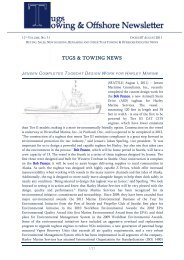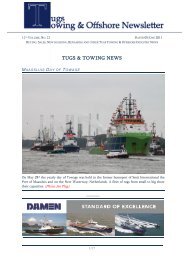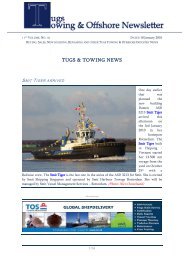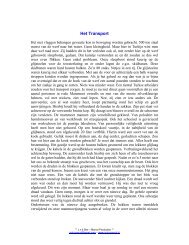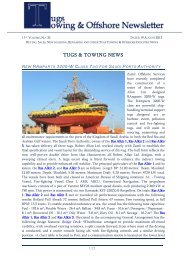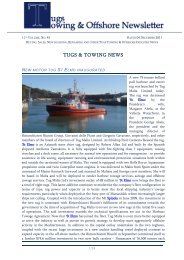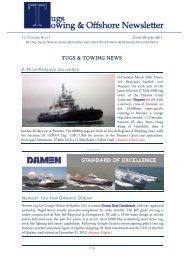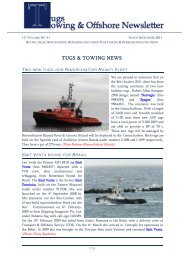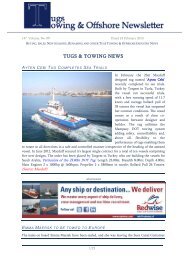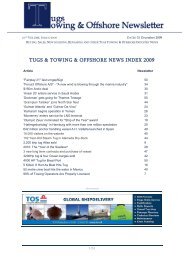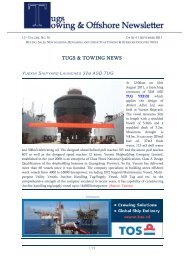Download Newsletter 13 2013 - Towingline.com
Download Newsletter 13 2013 - Towingline.com
Download Newsletter 13 2013 - Towingline.com
Create successful ePaper yourself
Turn your PDF publications into a flip-book with our unique Google optimized e-Paper software.
14 TH VOLUME, NO. <strong>13</strong> DATED 17MARCH 20<strong>13</strong><br />
is powered by two diesel engines driving<br />
twin fixed-pitch propellers, with twin<br />
rudders for each propeller. The wheelhouse<br />
is well laid out, with propulsion<br />
controls arranged on the main console<br />
amidships. A second control console is<br />
located at the after end of the boat deck<br />
abaft the funnels. Both control stations<br />
are fitted with pneumatic abort systems<br />
to allow the cable to run freely off the<br />
towing winch drum in the event of an<br />
emergency. (Photo: Robert Etchell)<br />
SAUSE BROS. STAYS FIT THROUGH CLOSE ATTENTION TO THE SHAPE<br />
ITS VESSELS ARE IN<br />
There are different models of fleet<br />
building among tug <strong>com</strong>panies. They<br />
vary according to the firm’s principal<br />
areas of operation, but they will vary<br />
within categories as well. Sause Bros.<br />
Inc., based in Coos Bay, Ore., with<br />
boats stationed in Hawaii, Los Angeles<br />
and Portland, continues to build a fleet<br />
based on the consideration of a wide<br />
range of performance factors. Recently,<br />
<strong>com</strong>pany president Dale Sause took<br />
some time to explain his <strong>com</strong>pany’s<br />
strategy. “It isn’t any one thing that<br />
makes a tug and barge efficient,” he explained. “It is a total of a lot of small things.” With a fleet of<br />
55 tugs and barges, and others being built or purchased, there are a lot of variables to be calculated.<br />
In addition to three crew boats serving the Los Angeles oil islands, they have six L.A.-based tugs,<br />
seven Honolulu tugs and 17 tugs based in Coos Bay. It is a collection of vessels that Sause and his<br />
team take pride in having put together. Growing up around the business when his dad and uncles<br />
ran it, Sause learned to respect a good tug. When his uncle had a heart attack, his dad told him to<br />
finish up his degree at the University of Washington and get back to working with the <strong>com</strong>pany.<br />
That was in the mid-70s and the majority of vessels in the <strong>com</strong>pany fleet were still single screw.<br />
They worked primarily towing lumber scows to California from Canada, Washington and Oregon.<br />
They were doing a little towing to Hawaii, but when the lumber business declined, they grew the<br />
Hawaii business. Sause had taken some engineering courses and understood the importance of<br />
<strong>com</strong>putational fluid dynamics (CFD) in marine design. In 2006 he spent a week in Sweden for tank<br />
testing of hydralift skegs on a new barge design with the late Josip Gruzling of Nautican Research &<br />
Development Ltd., in North Vancouver. Together with Sause’s own engineers, first Jack Wilskey<br />
and later Mark Babcock, and the naval architectural firm Hockema and Whalen, the <strong>com</strong>pany<br />
continues its quest for improved fluid dynamics. This is true for both barges and tugs. Sause Bros.<br />
has its new barges built at Gunderson Marine in Portland. Computer generated profiles show any<br />
turbulence that builds around the bow and stern. The <strong>com</strong>puter allows this to be modeled at various<br />
speeds. The design is then tuned to reduce the turbulence. “A barge shaped like a shoe box has a<br />
2/24



